A Foreigner's Mini Guide to Korean Ramen
KIM-CHI CHI-GAE
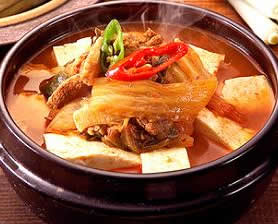 | |||||
KIM-CHI CHI-GAE
| |||||
Kimchi Chigae is a very popular soup made primarily with kimchi. It is often prepared using older, more fermented and ripe kimchi, creating a stronger and flavorful taste while fresh kimchi may not bring out the full and rich flavors. Different variations can exist but sliced kimchi is usually put into a pot with tofu, onions, garlic and beef, pork or seafood, which are all boiled together with water or anchovy stock. The soup is seasoned with either dwenjang and/or gochujang which contributes to the distinctive red color. Final soup is normally served in a stone pot and still boiling when served on the table. Typically, kimchi chigae is eaten with a bowl of rice accompanied by various side dishes. |
| RECIPE INGREDIENTS |
|
| COOKING DIRECTIONS |
|
| FEATURED ITEMS: SHOP ONLINe |
I LOVE KOREA RAMEN
How to Make Korean Ramen
소녀시대 신곡 "비주얼드림스 Visual Dreams" (인텔 콜라보레이션)
How To Cook Tasty Korean Ramen?

How Do I Cook Delicious Ramyun?
This question sounded strange to me first - how to cook delicious ramyun? To me, ramyun is tasty no matter what, and it’s very difficult to screw up with ramyun. You don’t need a lot of special skills to cook ramyun. To most Koreans, cooking ramyun is the easiest thing in the world.
But I realized that we could cook more delicious ramyun when I had ramyun in a restaurant specialized in ramyun only for the first time. Maybe ramen places had been popular in Japan much longer, but it’s been less than two decades since ramyun-specialized restaurants got popular in Korea, as far as I can remember.
The point is there ARE ways to cook more delicious ramyun!
Here are some tips about how to cook more tasty ramyun. I wasn’t initiated in the secrets from anybody in any way, so these are totally my ideas!
1. Add some more ingredients if possible.
There are tones of things that you can add to ramyun depending on your preference and imagination: mushrooms, potato, sausage, curry, milk, cheese, seafood, tuna from can, rice cakes, bean sprouts, garlics, spinach, hot pepper powder, vinegar, and so on.
The most common ingredients are eggs, dumplings, spring onions and kimchee. Obviously, these are additional ingredients, so pick whatever is available or whatever you’d like to. I usually add spring onions and eggs.
2. Get recently made ramyun if possible.
It’s said ramyun made within two weeks tastes the best because it absorbs water best. Unless you live in Korea, it’s very difficult to buy ramyun that recently made. But if possible, check the date when it’s made and get one made earlier. If you have ramyun that’s relatively old, it’s not a big deal as long as it’s within the expiration date. Just add more water when you cook old ramyun.
3. Turn the gas up to the highest and keep it like that while cooking ramyun.
The strength of heating power is very important. When you cook ramen, keep the gas at its highest. If you want to put the lid on after it’s boiled once, turn it down to the second highest. But it’s recommended not to put the lid on and keep the gas at its highest.
4. The amount of the water is important, too.
When I cook other Korean dishes, I usually use eye-ball measurements. But with ramyun, it’s a different story. Follow the directions of the package about the amount of the water, and it will make it more tasty.
Let’s cook delicious ramyun now!
This is for one serving.
(1) Boil 550ml water at the highest gas.
(2) Add the powder soup before the water boils. Stir it once or twice.
(3) When the water boils, put noodles in it. Once the noodles get loose, massage them by lifting with chopsticks a few times and stirring after. This will make the noodles more chewy.
(4) Boil the noodles for about 2.5 or 3.5 minutes without the lid on. This can vary depending on personal preferences. I like ramyun a little bit undercooked. But some people prefer to cook 4 minutes or more.
It’s said they cook for 2 or 3 minutes at a lot of ramyun restaurants. Another important thing is to keep the same heating power while boiling. Keep the gas at its highest!
(5) Egg! When and how to add an egg can vary as well depending on personal preferences. Some like to add it when they put the noodles and break it all the way. Others don’t want to break it to have a nicely-shaped yellow yolk.
If you like an undercooked egg, separate the white and yellow yolks, stir the white yolk and add it 2 or 3 minutes after you add the noodles. Then boil it whatever time you want. Add the yellow yolk at the end before you turn off the gas.
(6) Add some spring onions if you have 1 minute or 30 seconds before you turn off the gas.
(7) Serve it in a large bowl. Kimchi is the most recommended side dish for ramyun. Enjoy!
Other ingredients
You can add some red pepper powder (gochu-garu) for spicier taste.
You can add a drop of vinegar for more fresh taste.
You can add some milk for softer taste.

* Some of most popular ramyun in Korea
Shinramyun, Ansung Tangmyun, Neoguri, Kimchi Ramyun and so on



TUK-GUK
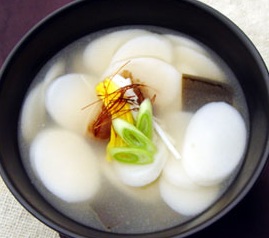 | |||||
TUK-GUK
| |||||
Tukguk is a traditional Korean soup dish that is eaten during the celebration of the Korean New Year. It is tradition to eat this soup on New Year's day because it’s believed to gain an additional year of life as well as bring in luck in the forthcoming year. The dish consists of thinly sliced rice cakes in a broth/soup and it’s usually garnished with thin julienned cooked eggs, some marinated meat (usually beef), and dried, crushed lavers. The broth is generally made by simmering the main protein (beef, chicken, pork, seafood) in a soy sauce-based seasoned stock. The stock is then strained to clarify the broth and long cylinder-shaped rice cakes (garaetteok) are thinly sliced diagonally and boiled in the broth. Garnish is added before serving and it may vary by region and personal taste. Varieties of tukguk exists but a popular one is tuk mandooguk which is made by simply adding Korean dumplings. |
| RECIPE INGREDIENTS |
|
| COOKING DIRECTIONS |
|
| ORDER SITE : http://list.gmarket.com.my/item/MADE-IN-KOREA-HOT-AND-SPICY-KOREAN-RAMEN-NOODLE/404830709 |
Kaesong lets Choco Pie fever get out of control
The chocolate-covered, marshmallow-and-cake confection is given to workers as snacks. But some workers are smuggling them out of the factories and selling them outside. The pies are viewed by some in the North as dangerous symbols of capitalism.
Recently, Pyongyang demanded that South Korean companies stop giving out pies and give cash to the workers instead.
At a meeting Nov. 10 among representatives of South Korean companies in the complex, the managers struggled to come up with a uniform Choco Pie policy. The problem, said one company representative at the meeting, was that each company gave different numbers of Choco Pies to their workers.
“The number varies greatly from company to company,” he said, “from three to four to over 10.” That inequality has apparently created discord among the 48,000 North Koreans working for more than 120 South Korean companies in the border city.
“The management should look into the actual situation and set up a recommended standard,” the company representative said.
As of now, the providing of snacks is up to the discretion of each company. But some companies outdo others in their Choco Pie largesse, and the other companies have trouble matching them.
The companies have rejected Pyongyang’s idea that the Choco Pies be stopped and cash be given instead, but haven’t received any response from the North.
The companies also expressed discontent that there was too little attention from the government or the industrial complex management to such problems in Kaesong.
Choco Pie
Export
In recent years Orion has used the Choco Pie to gain a foothold in foreign markets, and Orion now controls a two-thirds share of the Chinese snack market, with a third of Orion's revenue now coming from outside Korea. Around 12.1 billion Choco Pies have been sold all over the world.[clarification needed][1]
Orion seeks a share in four major markets - South Korea, Russia, Vietnam and China. The snack has also been particularly successful in India, Vietnam and Taiwan. Additionally, it has become a favorite snack of North Korean workers at the Kaesong Industrial Complexand has come to symbolize capitalism.South Korean news reports that Choco Pies can fetch as much as US$9.50 on the North Korean black market.
In South Korea, Choco Pie is associated with Jeong (情), which indicates closeness among people in Korea. Its advertisements emphasise the relationship between family members and friends, and its jingle is widely known.
ORDER SITE : http://list.gmarket.com.my/item/MADE-IN-KOREA-HOT-AND-SPICY-KOREAN-RAMEN-NOODLE/404830709
CHA-DOL BA-KI
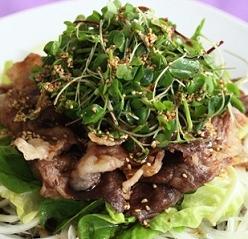 | |||||
CHA-DOL BA-KI
| |||||
Chadol Baki is a thinly sliced beef brisket meal that is also popular at homes or at Korean restaurants. The meat is not marinated whatsoever and it’s simply cooked on portable or built-in gas or charcoal grills. The meat is usually fattier than other parts of the beef, yet it’s thin enough that each slice doesn’t contain too much fat. And because of its thinness, each slice cooks very fast over open grills for quick bite after bites. Cooked chadol baki can be dipped in a sauce made up of sesame oil, salt, and pepper and eaten together with shredded scallion salad (pa muchim). Additionally, lettuce, spinach, or other leafy vegetable(s) can be used to wrap to all contents altogether along with a dab of dwenjang or ssamjang. To see visual illustrations, click here. Fresh packages of chadol baki meat can be purchase at Korean supermarkets or local meat markets. Pa muchim is also available for purchase but can be easily prepared at home. |
| RECIPE INGREDIENTS: PA MUCHIM |
|
| MIXING DIRECTIONS |
|
| FEATURED ITEMS |
 | 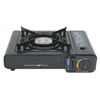 |  |  |  |
BUL-DAK Hot & Spicy Chicken
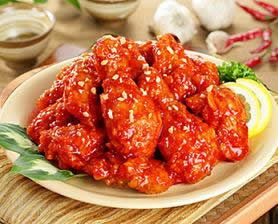 | |||||
BUL-DAK
| |||||
Buldak is a spicy chicken dish that is becoming very popular amongst the younger generation of Koreans everywhere. Its popularity has been attributed to both its unique flavors and spiciness. Keep in mind, the term bul means fire in Korean and dak is chicken, so it can get quite spicy in taste. Many restaurants that specialize in buldak have been created due to the growing popularity as this dish is considered fairly new. Also, most restaurants that serve this dish offer various levels of spiciness that one can choose from and there are usually fresh vegetables served with this dish to blend in the taste. Cubed-cut sweet radishes along with salad and onions are usually popular. An order of buldak can be served on a platter of bite-sized morsels of chicken breasts or sometimes in combinations of wings or drumsticks. While the flavor and degree of hotness differs a little from place to place, it is marinated with a hot & sweet sauce, grilled over an open fire, and then served over a sizzling skillet, topped with cheese as well as various herbs. It’s usually enjoyed as an appetizer while drinking a cold mekju or soju at popular bars or restaurants. |
| RECIPE INGREDIENTS: CHICKEN PREPARATION |
|
| RECIPE INGREDIENTS: MARINATING SAUCE |
|
| COOKING DIRECTIONS |
|
| FEATURED ITEMS |
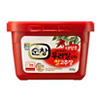 |
DAE-JI BUL-GO-GI
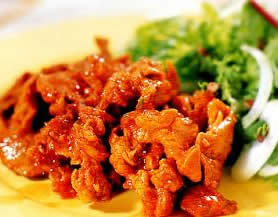 | |||||
DAE-JI BUL-GO-GI
| |||||
Daeji Bulgogi is another popular Korean meat dish similar to bulgogi. However, instead of using beef, thin sliced pork loin is marinated in a specially blended red chili pepper paste with various assortments of vegetables. The meat is marinated with a mixture of soy sauce, sesame oil, garlic, sugar, ginger roots, rice wine and gochujang which is the base sauce for this dish. It is marinated for 30-60 minutes to bring out the depth and intensity of flavors. Daeji bulgogi can be grilled or pan-cooked and it is usually served with a side of lettuce, spinach, or other leafy vegetable, which is used to wrap a slice of cooked meat. It is often times wrapped along with a dab of ssamjang, kimchi, or other side dishes, and then eaten as a whole. To see a visual illustration, click here. Korean 101: Daeji means pork in Korean and bulgogi is the word for fire meat, therefore, it translates into pork fire meat. Since gochujang is the base sauce to this dish, it can get spicy in taste. |
| RECIPE INGREDIENTS |
|
| COOKING DIRECTIONS |
|
| FEATURED ITEMS |
 |  | 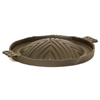 |  |  |









0 comments: